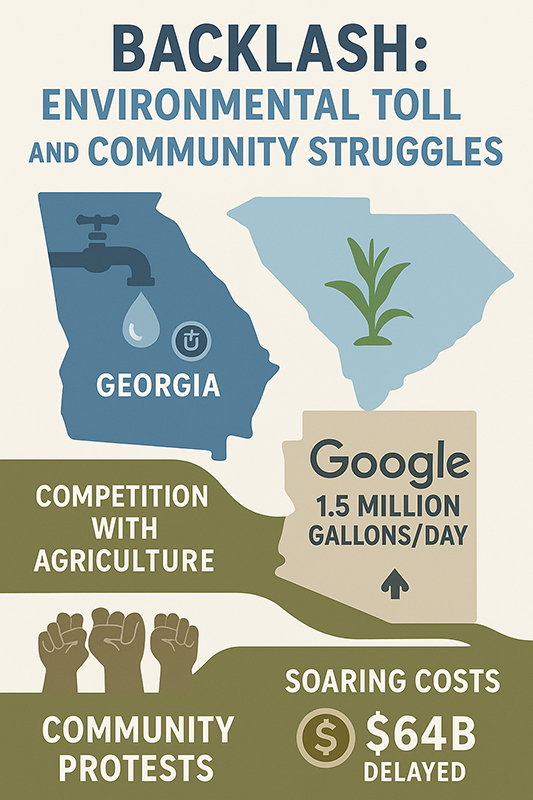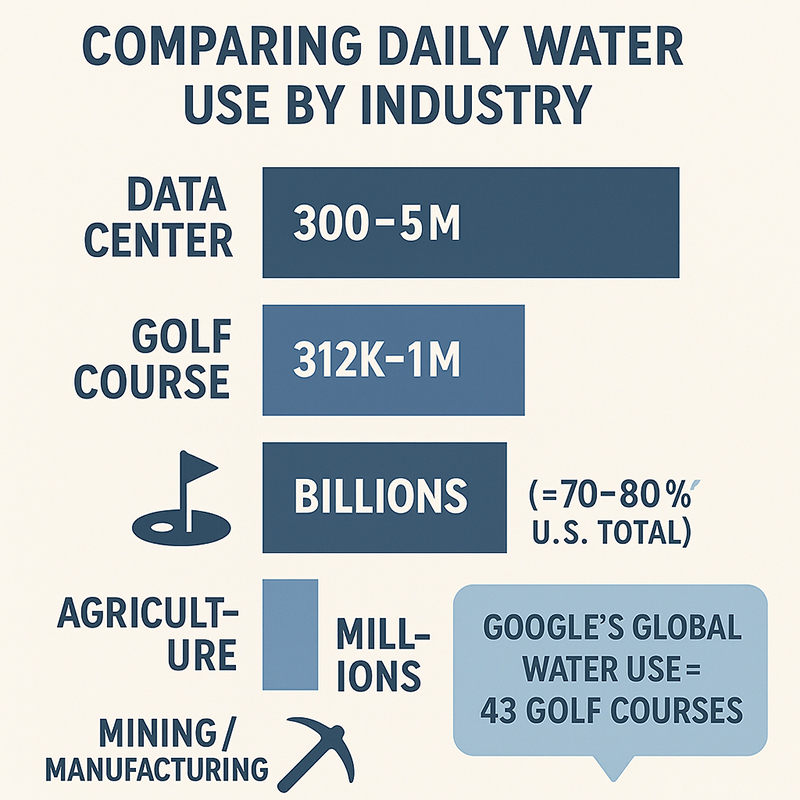The Thirsty Servers: The Truth About Water Footprint of Data Centers
In an era where artificial intelligence and cloud computing power our daily lives, the infrastructure supporting it has come under increasing scrutiny. This article considers the water usage of these digital behemoths. We’ll examine how much water they consume, the growing backlash over their environmental and community impacts, comparisons to other water-intensive industries, and the innovative steps the sector is taking to quench its thirst more sustainably.
The Scale of Water Use in Data Centers
Keeping servers cool is a resource-intensive task. Most data centers rely on cooling systems where water is used to dissipate heat. This process can be incredibly water-hungry, especially in hot climates or during peak loads.
A medium-sized data center might consume around 110 million gallons of water annually for cooling purposes. To put that in perspective, a single facility can guzzle up to 5 million gallons of drinking water per day. This is enough to supply thousands of households or irrigate farms. Globally, data centers rank among the top 10 water-consuming commercial industries in the U.S., with collective usage straining local supplies. Tech giants like Google report using 6.4 billion gallons across their data centers and offices in a single year, highlighting the exponential growth driven by AI demands.
The indirect water footprint is even larger, as power generation for data centers often requires additional water. With AI workloads surging, projections suggest water consumption could spiral further, exacerbating global scarcity issues.
Backlash: Environmental Toll and Community Struggles
The rapid expansion of data centers hasn’t gone unnoticed, sparking widespread backlash from environmentalists, farmers, and local residents. In water-stressed regions, these facilities are accused of draining precious resources, leading to dried-up wells, soaring municipal water costs, and disrupted ecosystems.
In rural Georgia, for instance, communities near Meta’s data centers report contaminated or depleted water supplies, with one resident lamenting, “I can’t drink the water.” Similar stories emerge from Arizona, where data centers compete with agriculture for limited water, potentially reducing crop yields and inflating prices for farmers. In South Carolina, conservation groups criticized Google’s permit to draw 1.5 million gallons daily, arguing it prioritizes tech over local needs.
Environmentally, the impacts are profound. Data centers worsen drought conditions in already vulnerable areas, contributing to habitat loss and biodiversity decline. In the American West, where water scarcity affects millions, the cooling demands of these centers threaten rivers and aquifers, prompting calls for moratoriums on new builds. Critics argue that while tech companies tout sustainability, their opaque water usage data hides the true cost to communities and the planet.
This tension has led to project delays and blocks worth $64 billion, as locals push back against noise, energy strain, and water hogging in the name of “anti-tech” sentiment.

Putting It in Perspective: How Data Centers Stack Up Against Other Industries
While data centers’ water use is significant, it’s worth comparing them to other sectors to avoid undue vilification. Agriculture, for example, dominates water consumption in many areas, accounting for 86% of total usage in states like Arizona, dwarfing the industrial share that includes data centers at around 8%.
Take golf courses, often cited as a benchmark for inefficiency. A typical 18-hole golf course in the U.S. uses about 312,000 gallons of water per day for irrigation, particularly in arid areas like Palm Springs. In hotter climates, this can climb to 1 million gallons per night or up to 2.08 billion gallons annually for an 18-hole facility. Nationally, golf courses collectively use around 2 billion gallons daily, representing 0.5% of U.S. water withdrawals.
How do data centers compare? A single Google data center in Virginia consumed 173.2 million gallons in a year. This equivalent to about 1.2 golf courses. But it is serving millions of people worldwide, so on a per person basis, its water use is much lower than a golf course that caters to a few hundred members. Google’s global footprint equals roughly 43 golf courses. However, data centers often recycle water or use non-potable sources, whereas golf courses typically draw from freshwater for turf maintenance. Mining and manufacturing also rival or exceed data centers in water intensity, but agriculture remains the heavyweight.
| Industry/Sector | Average Daily Water Use (Gallons) | Key Impacts |
|---|---|---|
| Medium Data Center | 300,000 – 5,000,000 | Strains local supplies in drought areas; indirect energy water use |
| Typical Golf Course | 312,000 – 1,000,000 | Irrigation in arid regions; chemical runoff affects ecosystems |
| Agriculture (U.S. Overall) | Billions (70-80% of total water) | Crop irrigation; major cause of aquifer depletion |
| Mining (Per Operation) | Varies, often millions | Contamination and habitat disruption |

Tackling the Issue: Innovations and Efficiency in the Data Center Industry
The good news? The data center industry isn’t ignoring the problem. Companies are investing in technologies and metrics to curb water use, aiming for “water-positive” operations where they replenish more than they consume.
A key metric is Water Usage Effectiveness (WUE), which measures efficiency by dividing total onsite water consumption (in liters) by the energy used for IT equipment (in kilowatt-hours). Lower WUE scores indicate better performance; for example, Microsoft tracks WUE to optimize humidification and cooling, targeting reductions through real-time adjustments. Best practices include collecting usage data, reusing wastewater, and shifting to air-based or hybrid cooling systems.
To reduce consumption, operators are adopting advanced cooling methods. Direct-to-chip cooling circulates liquid directly over processors, slashing water needs by up to 95% in some cases. Immersion cooling submerges servers in non-conductive fluids, eliminating evaporative water use entirely. Water-side economizers leverage cooler outdoor air to minimize evaporation.
Looking ahead, future technologies promise even greater strides. Circular water systems treat and recycle onsite water, potentially achieving zero net consumption. Water-free data centers, using advanced air cooling or geothermal methods, are on the horizon, though challenges like salt corrosion in seawater alternatives persist. Microsoft, for one, pledges a 95% reduction in evaporative water use by 2024, while others explore AI-optimized systems for predictive efficiency.

Conclusion: Balancing Innovation and Sustainability
Data centers’ water appetite is real and growing, fueling valid concerns about environmental harm and community equity. Yet, when viewed alongside golf courses, agriculture, and other industries, it’s clear the issue demands holistic solutions. By embracing metrics like WUE and breakthrough technologies, the sector can evolve into a more sustainable force. As AI reshapes our world, ensuring its infrastructure doesn’t dry up our resources will be key to a tech-driven future we can all live with. What are your thoughts. Should data centers face stricter water regulations?
